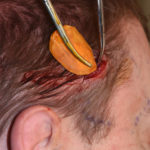Like all facial implants, temporal implants comes in a number of standard sizes and styles. Standard and extended implants exist to cover either the anterior lower temporal (zone 1) or the both anterior lower and upper temporal areas. (zone 1 and 2 or extended style) Within these two styles there are also various thicknesses (sizes) of them.
While these implant options are adequate for the majority of patient aesthetic needs, some patient’s end up as ‘tweeners’, meaning one size option seems too small but the larger implant option seems too big. Because there is no precise preoperative sizing method, this aesthetic discovery is often not made until surgery with the implant in place.
When the surgeon feels that the temporal implant is not big enough in width during surgery, the shim option exists. This is a technique where a smaller implant material is placed behind the indwelling implant to give it an increased size. This is a particularly useful intraoperative technique with temporal implants because it is a flat surface unlike any other facial implant. As such the shim can similarly be flat and it will not adversely affect the external contour it creates.

Like all facial implants temporal implant sizing is not an exact science. During surgery it may be discovered that the implant size may be more or less than one anticipated before surgery. In temporal implants that need a little more with a shim of ePTFE material may just be what is needed.
Dr. Barry Eppley
Indianapolis, Indiana


